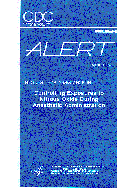Controlling Exposures to Nitrous Oxide During Anesthetic Administration
1994
DHHS (NIOSH) Publication Number 94-100

WARNING! Workers exposed to nitrous oxide (N2O) may suffer harmful effects.
The National Institute for Occupational Safety and Health (NIOSH) requests assistance in controlling exposures of workers to nitrous oxide (N2O) during the administration of anesthetic gas in medical, dental, and veterinary operatories. NIOSH concluded in 1977 that exposure to N2O causes decreases in mental performance, audiovisual ability, and manual dexterity [NIOSH 1977b]. A recent study of workers [Rowland et al. 1992] and several experimental animal studies [Corbett et al. 1973; Vieira 1979; Vieira et al. 1980, 1983] indicate that adverse reproductive effects may also result from chronic exposure to N2O.
This Alert presents control measures for preventing or greatly reducing exposure to N2O during the administration of anesthetic gas. These control measures should be part of a comprehensive written safety and health plan for workers. NIOSH requests that safety and health officials, editors of appropriate journals, manufacturers of anesthetic equipment, union representatives, employers, and managers bring the recommendations in this Alert to the attention of all workers who are at risk.
Controlling Exposures to Nitrous Oxide During Anesthetic Administration
